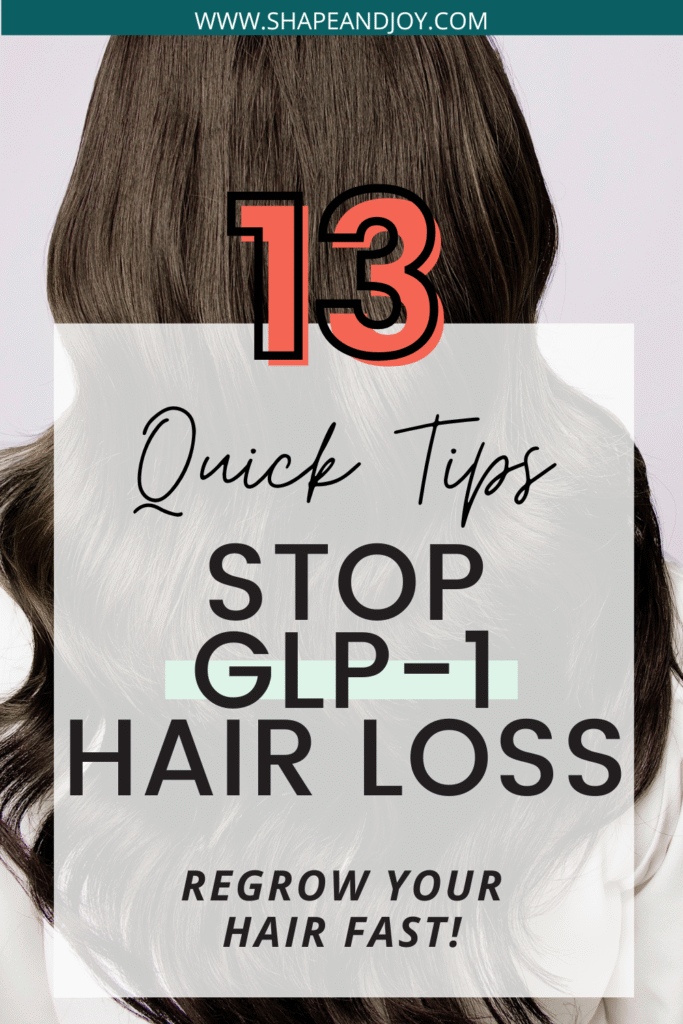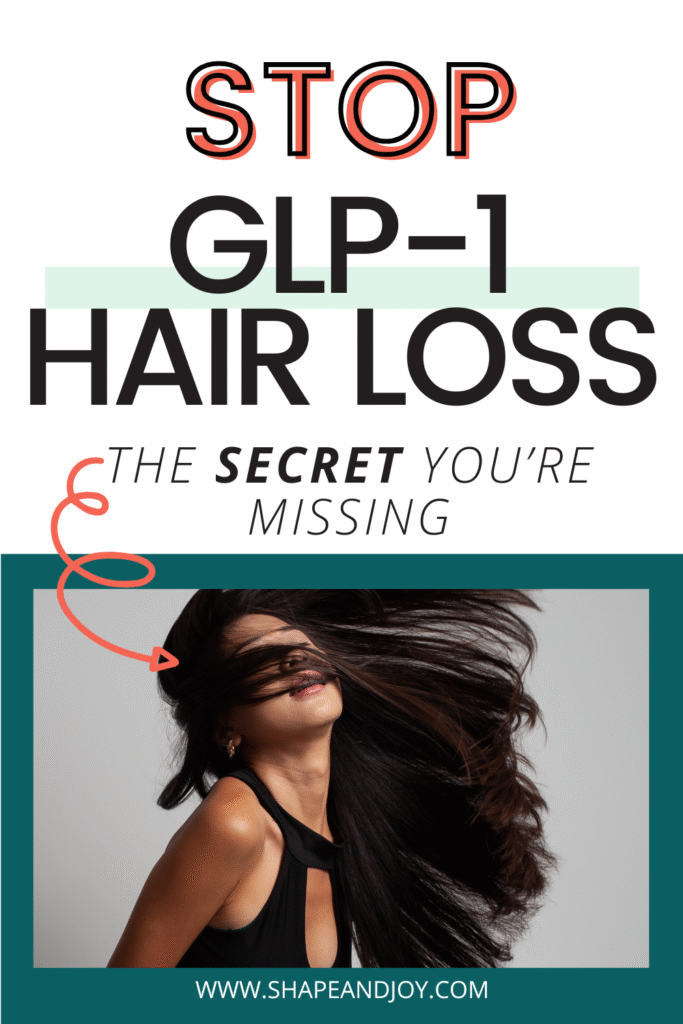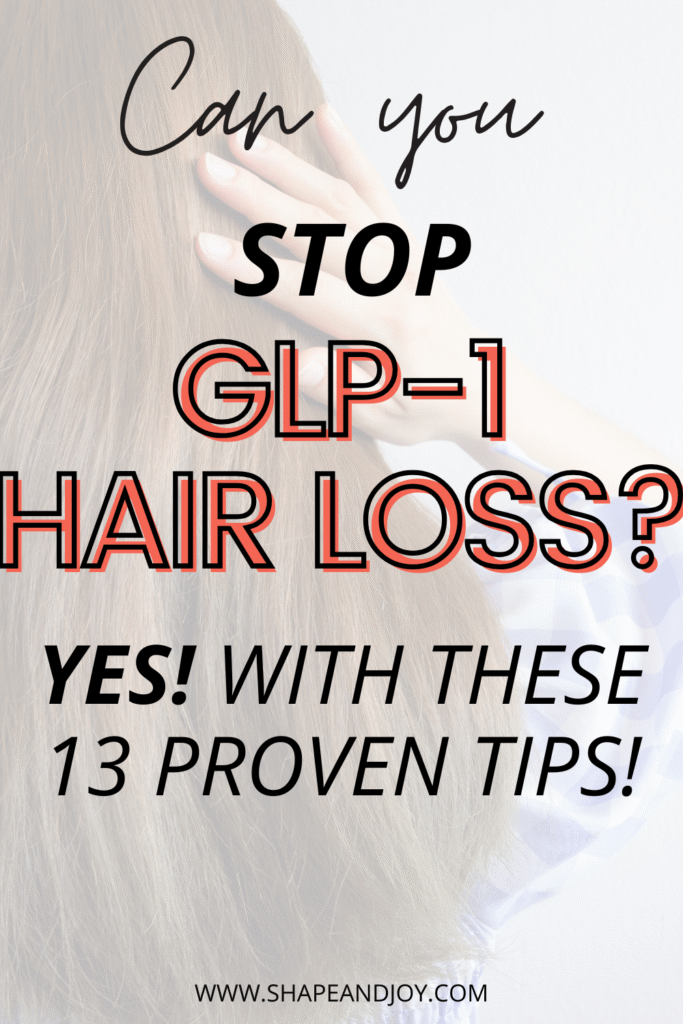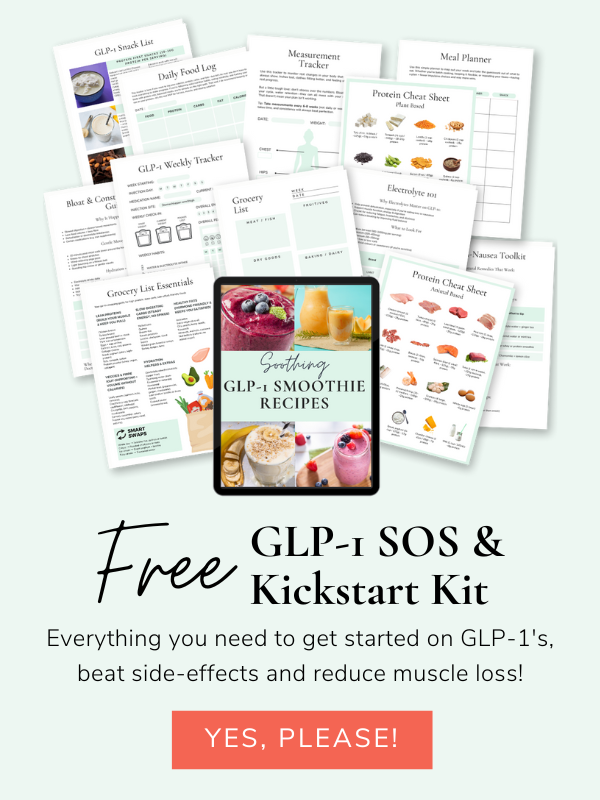This post may contain affiliate links, which means that I may earn a commission if you click on the link, with no cost for you. It’s one of the ways I support my blog. You can read more about this here.

Did you know that up to 30% of people experience hair loss during rapid weight loss? If you’re noticing more hair in the shower drain while on GLP-1 medications like Mounjaro, Zepbound, or Wegovy, you’re not alone—and you’re definitely not imagining it.
Hair loss can feel like a cruel joke when you’re finally making progress with your weight loss journey, can’t it? You’ve worked hard, you’re seeing results, but suddenly your hair’s thinning faster than your waistline. But here’s the thing: GLP-1 hair loss is actually a pretty common side effect, especially when weight is dropping quickly.
But here’s the good news: Hair loss doesn’t have to be permanent. In fact, with a few smart, science-backed habits, you can protect your hair, encourage new growth, and keep your hair looking full and healthy while you crush your weight loss goals.
Ready to turn things around? Let’s dive into 13 easy, effective tips that can help you prevent GLP-1 hair loss and bring back that luscious, full hair you love.
Why Does Hair Loss Happen on GLP-1s (and Any Weight Loss Journey)?
When you’re losing weight—especially rapidly—your body goes into a bit of a shock. Here are the most common reasons for hair thinning during weight loss, including on GLP-1 medications:
- Nutritional Deficiencies: Cutting calories or changing your diet can mean you’re not getting enough of the vitamins and minerals your hair needs (zinc deficiency, iron deficiency, and biotin – we’ll get into it!).
- Protein Prioritisation: Your body is smart. When you’re in a calorie deficit, it prioritises vital organs over “non-essential” parts like hair. If you’re not eating enough protein, your hair is the first to suffer.
- Hormonal Changes: Rapid weight loss can mess with your hormones, which can trigger hair shedding. And GLP-1 medications can affect your hormone balance too, which might add to the problem.
- Increased Stress (Cortisol Chaos): Any big change, including weight loss, can be a form of stress on your body. High cortisol levels are bad news for hair growth and can lead to a lovely thing called “telogen effluvium” (fancy name for stress-induced hair shedding).
- Medication Side Effects: GLP-1s can have a range of side effects, and while hair loss isn’t the most common, it’s not unheard of. For some, it might be linked to reduced appetite, leading to nutrient deficiencies.
But don’t you dare give up on your goals! Just because hair loss can happen doesn’t mean it will last. The trick is being proactive. With a few smart steps, you can maintain healthy hair, encourage new hair growth, and feel good about your progress.
Right, let’s get stuck into the best hair loss tips for anyone on GLP-1s (or any weight loss journey, really.)
1. Prioritise Collagen Protein in Your Diet
Here’s the thing: your hair’s not just for looking fabulous—it’s made of protein. And one of the best proteins for maintaining healthy hair while on GLP-1s is collagen. Why? Because collagen supports your hair’s structure, strength, and elasticity. Plus, it’s an absolute winner for skin and nails too.
Try this: Add a daily scoop of hydrolysed collagen peptides to your coffee, smoothie, or even your morning porridge. It’s easy, it’s quick, and your hair will thank you. No more hair shedding drama—just full hair vibes.
2. Optimise Your Overall Nutrition
Listen, no amount of fancy shampoo will make up for nutritional deficiencies. Hair needs proper fuel to thrive, and if you’re skimping on nutrient-dense food, your hair might be the first to complain. Zinc deficiency, iron deficiency, or a lack of protein can make your hair look as tired as you feel on a Monday morning.
Try this: Pack your meals with iron-rich foods (think spinach and lean beef), vitamin C (like oranges and peppers), and omega-3s (chia seeds or walnuts). Balance those macros, keep it nutrient-dense, and don’t skip meals—your hair needs fuel!
Here’s a smoothie to start your day with, loaded with vitamins and minerals that support healthy hair:
Hair-Loving Superfood Smoothie
- 1 cup fresh spinach (30g) – Iron, folate, and vitamin C for scalp health (7 calories)
- 1 medium orange, peeled (130g) – Vitamin C for collagen production (62 calories)
- 1 tablespoon chia seeds (12g) – Omega-3 fatty acids for hair strength (60 calories)
- 1/2 cup Greek yoghurt (100g, 0% fat) – Protein for strong, thick hair (57 calories)
- 1/2 medium banana (50g) – Potassium and B vitamins (53 calories)
- 1 cup unsweetened almond milk (240ml) – Vitamin E for scalp health (30 calories)
- 1 scoop collagen peptides (20g) – Extra protein for hair structure (60 calories)
Total Calories: 339
Blend everything together with some ice, and you’ve got a refreshing, nutrient-packed start to your day that your hair will love.
Oh, and a quick pro tip: The vitamin C in that orange isn’t just for flavour—it’s the key to boosting iron absorption from the spinach. Plant-based iron (non-heme iron) can be harder for your body to absorb, but vitamin C helps turn it into a form your body can actually use. So don’t skip it—your hair follicles will thank you.
3. Don’t Skip Your Multivitamin
Now, I know what you’re thinking—do vitamins really help? Spoiler alert: yes. Hair loss and hair thinning can often be traced back to a lack of key nutrients. Think of a good multivitamin as a little insurance policy against the nutritional gaps that might sneak in.
Try this: Pick a multivitamin that’s loaded with biotin, zinc, iron, and vitamin D. Hair supplements specifically designed for hair, skin, and nails are a solid shout too. Easy, peasy—just take one a day.
4. Manage Stress Levels (Cortisol Control)
Here’s a little-known secret: stress and high cortisol levels can trigger hair shedding. Yep, your scalp’s having a meltdown because life’s too hectic.
Try this: Practise mindfulness, deep breathing, or just take a few minutes to do absolutely nothing. Your hair—and your sanity—will appreciate it. You can also go and check out my post ‘The Ultimate Guide to Reducing Your Cortisol Levels‘.
5. Stay Hydrated for Scalp Health
We all know we should drink more water, but when your hair’s feeling brittle and your scalp’s flaking like a dodgy old poster, it’s a big sign to up your hydration game.
Try this: Aim for 2-3 litres of water a day. Herbal teas count too, so swap your afternoon latte for a peppermint tea (this also helps with nausea on GLP-1s – win-win!)
Hydration is key to new hair growth and keeping your scalp happy.
📌 Pin this for later! ⬇

6. Use a Gentle, Nourishing Shampoo
If your hair’s falling out faster than your patience, it might be time to ditch the harsh shampoos. Sulphates and other nasties can dry your scalp and weaken your hair.
Try this: Go for a sulphate-free shampoo with hydrating ingredients like aloe vera or coconut oil. Treat your hair like the queen it is, not like a greasy pan needing a scrub.
I 100% recommend the Kitsch Rosemary & Biotin Shampoo and Conditioner Bar Set. It’s like a spa day for your scalp. Packed with rosemary to stimulate growth and biotin to strengthen strands, it’s a solid (literally) choice for anyone dealing with thinning hair. Plus, it’s eco-friendly (because we love sea-turtles here at Shape & Joy!) and perfect for travel.
7. Consider a Biotin Supplement
Biotin is your hair’s best mate when it comes to maintaining healthy hair. It’s a B vitamin that helps boost hair strength and thickness—exactly what you need when GLP-1 side effects are playing silly buggers with your follicles.
Try this: Go for a biotin supplement with around 5,000–10,000 mcg. It’s a small change with big results—like finding a fiver in your coat pocket.
8. Opt for Protective Hairstyles
Let’s be honest—tight ponytails and fancy braids look cute, but they can also pull your hair out. Literally. Choose styles that are gentle on your hair and protect it from breakage.
Try this: Loose buns, twist-outs, and low-manipulation styles are your new besties.
9. Sleep on Silk or Satin
This one’s an absolute game-changer. Regular pillowcases can cause friction and lead to breakage. If you’re serious about keeping that full hair dream alive, silk or satin is the way to go.
Try this: Switch to silk or satin pillowcases, scrunchies, and bonnets. It’s posh, it’s practical, and your hair will stay smoother and less frizzy.
10. Use a Nourishing Hair Oil
A good hair oil keeps your strands strong and shiny, even when GLP-1 side effects make them feel a bit sad.
I personally recommend the Kitsch Rosemary & Biotin Hair & Scalp Oil—it’s basically a little bottle of magic for your scalp. It’s packed with rosemary to wake up lazy follicles and biotin to keep your strands strong. Just massage a few drops into your scalp before wash day, and let it work its magic. Plus, it smells AMAZING and comes in an eco-friendly bottle.
11. Minimise Heat Styling and Tight Hairstyles
We all love a sleek blow-dry, but daily heat styling can leave your hair looking fried. Give your hair a break and try some heatless styling hacks instead.
Try this: Air-dry when you can, or keep your tools on a low-heat setting. Your hair’s fragile right now, so be gentle.
12. Get Regular Scalp Massages
It’s not just a nice treat—scalp massages stimulate blood flow and can help encourage hair regrowth. Plus, it feels soooo nice, and who doesn’t need a bit of pampering?
Try this: Use a scalp massage brush or your fingertips for a few minutes every night. If you’re feeling fancy, add a drop of nourishing oil.
13. Track Your Progress with Photos
Hair growth is slow, and when you’re fretting every day, it’s easy to forget just how far you’ve come. Tracking progress helps keep your spirits up.
Try this: Snap a photo once a month of your hairline and scalp. You might just be surprised at how much new hair growth you see after a few weeks.
Your GLP-1 Game Plan Starts Here
Feeling a bit lost on your GLP-1 journey? Whether you’re just starting out or deep into your dose increases, the GLP-1 Success Blueprint is your practical, no-fluff guide to navigating weight loss meds like Mounjaro, Zepbound, or Wegovy with confidence.
This isn’t another generic ebook. It’s a full toolkit designed to help you feel strong, informed, and in control, without the overwhelm.

Inside, you’ll get:
- GLP-1 Meds 101: Understand how they work, what to expect, and how each med compares (minus the jargon)
- Nutrition Guidance: Learn how to eat for fat loss and muscle retention, even when your appetite is low
- Workout Support: Discover the best ways to move your body without burning out
- 6-Week Action Plan: Simple daily steps and healthy habit examples to follow at your pace
- Mindset & Motivation Tips: Stay consistent even when your drive dips
- Red Flag Checklist: Know what’s normal, what’s not, and when to seek support
- Bonus: Myths & FAQs – Bust the most common GLP-1 myths and get real answers
Digital download only – use it on your phone, tablet, or print it out to keep by your side.
Ready to ditch the guesswork and actually feel good on your meds?
You Might Also Like
- GLP-1 Fatigue Fix: Get Your Energy Back
- GLP-1 Dry Mouth and Dehydration: Stay Refreshed and Hydrated
- GLP-1 Constipation Relief: How to Stay Regular Without Feeling Miserable
Conclusion
GLP-1 hair loss might feel like a cruel twist on your weight loss journey, but it doesn’t have to be a permanent problem. By focusing on nutrient-dense food, protecting your hair with gentle styles, and giving your scalp the TLC it deserves, you can protect your strands, encourage new growth, and keep your confidence intact.
We’ve covered everything from the power of collagen protein and biotin to the soothing magic of scalp massages and the simple, game-changing swap to silk pillowcases. You know the culprits behind GLP-1 hair loss—nutritional deficiencies, stress, tight hairstyles—and now you have a full toolkit of easy, science-backed tips to fight back.
But most importantly, remember this: hair is just one part of your journey. Your health, your energy, and your confidence are what truly matter. Hair can regrow—confidence lasts. So take a deep breath, keep looking after yourself, and know that you’re doing an amazing job.
Got a friend who’s stressing over GLP-1 hair loss? Send them this post—they’ll thank you later.
📌 Pin this for later! ⬇

Studies
Collagen’s Anti-Hair Loss Effect: Another study found that fish-derived collagen peptides reduced hair shedding and improved hair density. In clinical trials, those who took collagen saw a 27.6% increase in hair density compared to placebo (Reilly et al., 2024).
Biotin and Weight Loss-Related Hair Loss: In a study of patients undergoing weight loss surgery, those with biotin deficiency and hair loss experienced significant improvements when given biotin supplements (Şen & Türkçapar, 2020).
Iron Deficiency and Hair Loss: Iron is critical for maintaining healthy hair growth, and iron deficiency is one of the most common causes of hair loss. Research shows that low serum ferritin levels (a marker of iron stores) are significantly associated with chronic diffuse hair loss, particularly in women (Ananya et al., 2020).
Stress and Hair Growth Disruption: Chronic stress and elevated cortisol levels can significantly disrupt the hair growth cycle, accelerating hair shedding and thinning. A study demonstrated that high cortisol levels can directly damage hair follicles, reducing their ability to regenerate healthy hair (Thom, 2016).








